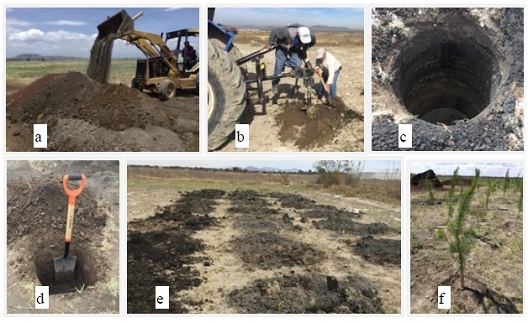El desafío para establecer especies arbóreas en suelos salinos del ex lago Texcoco
DOI:
https://doi.org/10.28940/terra.v41i0.1593Palabras clave:
conductividad eléctrica, pH, Pinus spp, Psidium guajava, suelo salino‑sódico, sustratoResumen
Dado la presión por urbanizar áreas con presencia de suelos salino-sódicos (SSS) alrededor del ex lago de Texcoco, México, es importante encontrar estrategias para arborizarlas. El objetivo del estudio fue determinar la respuesta de cinco especies arbóreas; Pinus greggii, P. pseudostrobus, P. ayacahuite, P. leiophylla y como especie de referencia Psidium guajava, establecidas en cepas con un sustrato alternativo (CSA) en SSS. Se realizaron 50 cepas de 1 m de profundidad con 0.60 m de diámetro y se rellenaron con el sustrato alternativo. Se midió el pH, la conductividad eléctrica (CE), la resistencia mecánica, el contenido volumétrico de humedad, el contenido hídrico relativo (CHR) en tejido vegetal y la supervivencia a 280 días. Las CSA presentaron menores valores respecto al testigo (SSS): en pH, 8.99 vs. 9.95; en CE, 2.58 vs. 8.19 dS m-1; en resistencia mecánica, 1.72 vs. 2.53 MPa; y en el contenido volumétrico de humedad, 0.41 vs. 1.06 cm3 cm-3. El CHR aumentó a los 120 días en P. ayacahuite (de 74.7 a 81.5%) y P. leiophylla (75.2 a 77.5%), mientras que en P. guajava disminuyó (92.8 a 75.5%). La supervivencia a los 280 días de P. guajava (70%) superó a la de los pinos (1.67%). Durante el tiempo de evaluación P. guajava se adaptó mejor, mientras que los pinos fueron menos tolerantes. Las CSA podrían ayudar en el establecimiento de especies arbóreas propiciando un entorno saludable a pesar de las condiciones adversas del SSS.
Descargas
Publication Facts
Reviewer profiles N/D
Author statements
- Academic society
- Terra Latinoamericana

















